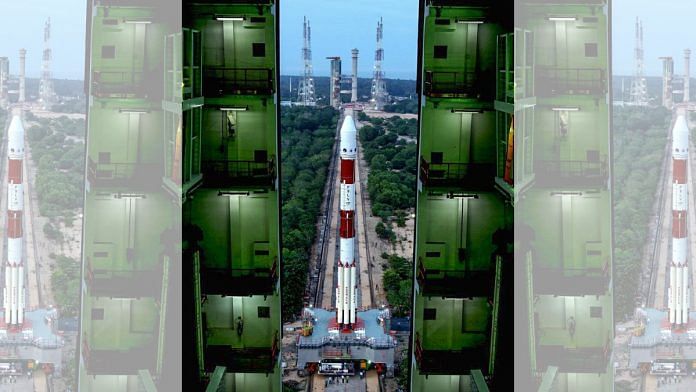New Delhi: The Indian Space Research Organisation (ISRO) successfully launched its first solar mission, Aditya-L1, into space from the Satish Dhawan Space Centre at Sriharikota, Saturday.
This is India’s first dedicated solar mission, and comes just days after its space agency made a successful landing near the lunar south pole for the first time. It is also the 59th launch of PSLV and the seventh successful launch this year.
The satellite, which contains seven payloads that will study the Sun and its effect on the interplanetary medium, was launched aboard ISRO’s PSLV C57 rocket at 11.50 am.
“Congratulations, the Aditya-L1 orbit has been successfully injected into an elliptical orbit of 235×19500 km,” ISRO chairperson S. Somanath said.
“This was the first time that PSLV executed two engine burns in space…Aditya-L1 will now embark on an almost 135 day long journey to the L1 point,” he added.
Minister of State for Science and Technology and Department of Space, Jitendra Singh said, “Congratulations, India. Congratulations, ISRO. While the whole world watched this with bated breath, it is indeed a sunshine moment for India.”
“Indian scientists have been working for years and years. Now comes the moment of vindication,” he added.
About an hour into the flight, the spacecraft successfully separated from the propulsion system and was placed in the injection orbit. For Aditya-L1, ISRO has developed advanced flight dynamics software for better tracking and path prediction of its satellite
Over the coming weeks, the satellite will perform a series of orbit raising manoeuvres, before heading towards what is known as the Lagrange 1 point. It will take the satellite almost four months to reach its destination.
Aditya-L1 will orbit this point and make observations about the Sun’s surface. The Lagrange 1 point is 1.5 million kilometres from the Earth, which is just about 1 percent of the distance between the Earth and the Sun.
The main objective of the Aditya-L1 mission is to observe the solar atmosphere, mainly the corona and chromosphere, the first and second layer making up the Sun’s outer layer. It has a third layer called the photosphere.
“Both solar and heliophysics depend on data. And the Sun is the start of our life so it is important to understand,” Dr Sankaran Subramanian, Principal Scientist, Aditya-L1 said. “We made sure that we will have unique datasets which is not available from anywhere else,” he added.
The spacecraft’s payloads will study the solar upper atmospheric dynamics, chromospheric and coronal heating, physics of the partially ionised plasma, initiation of the coronal mass ejections, and flares. It will also observe the in-situ particle and plasma environment, providing data for the study of particle dynamics from the Sun, physics of solar corona and its heating mechanism, as well as drivers for space weather.
“Mass from ejections from the Sun can take 2 to 4 days to be ejected from the Sun. With Aditya-L1, we are trying to see coronal mass ejections and solar flares from the Sun,” said Dr Anil Bhardwaj, Director, Physical Research Laboratory, the organisation that provided ASPEX payload.
Also read: After the Moon, India guns for the Sun. All eyes on Aditya-L1, ISRO’s first solar mission
Payloads on Aditya-L1
The Visible Emission Line Coronagraph (VELC) — its main payload — will take images of the Sun’s corona. This instrument is designed to capture sudden solar flares, as well as piece together an overall image of the Sun’s corona by taking a few pictures at a time.
The Solar Ultraviolet Imaging Telescope (SUIT) on board Aditya-L1 will measure and monitor the solar radiation emitted in the near-ultraviolet wavelength range (200-400 nanometres). It will simultaneously map the photosphere and the chromosphere of the Sun using 11 filters sensitive to different wavelengths, and covering different heights in the solar atmosphere. This will help us understand the processes involved in the transfer of mass and energy from one layer to the other.
The Solar Low Energy X-ray Spectrometer (SoLEXS) instrument will detect soft X-ray energy. The instrument is meant to complement VELC by making independent and accurate estimates of temperature and emission measure at flaring sites.
The High Energy L1 Orbiting X-ray Spectrometer (HEL1OS) will observe the hard X-ray (HXR) emission from the Sun in the energy range of 10-150 kilo-electron-volt (keV). This will provide direct information of electrons accelerated in flares.
To study the solar winds, the Aditya-L1 will make use of two payloads—the Aditya Solar wind Particle EXperiment (ASPEX) and Plasma Analyser Package for Aditya (PAPA).
ASPEX’s primary objective is to understand the solar and interplanetary processes (like shock effects, wave-particle interactions etc.) in the acceleration and energisation of the solar wind particles from L1 point. To achieve these objectives, ASPEX measures low as well as high energy particles associated with slow and fast components of solar wind.
PAPA, on the other hand, aims to study the composition of solar winds and energy distributions.
Advanced Tri-axial High Resolution Digital Magnetometers will also be used for sensing the magnetic field at the L1 point to help ISRO keep track of the orientation of the Aditya-L1 spacecraft.
(Edited by Smriti Sinha)
Also read: On eve of ISRO’s Aditya-L1 launch, a look at solar missions from around the world



